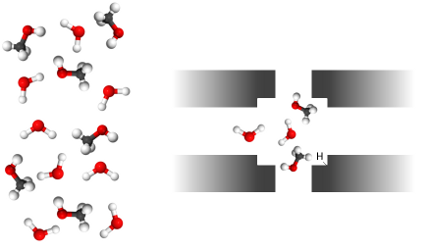Impact of nuclear quantum effects on proton mobility in nanoporous materials
Impact of nuclear quantum effects on proton mobility in nanoporous materials
Promotor(en): V. Van Speybroeck /15_NANO10 / Nanoporous materialsUnderstanding the properties of water has attracted intense attention of many theoreticians and experimentalists during the last decade, not in the last due to its importance for the climate and life on Earth. A proper understanding of the hydrogen bond is mandatory to describe the physical properties of water properly. Some recent studies showed that the hydrogen-bonded protons in liquid water experience significant excursions towards acceptor oxygen atoms. Such proton shuttles give serious rearrangements of the electron density.
A theoretical description of these proton walks is very challenging as it requires a proper account of nuclear quantum effects (NQEs). Most of the simulations performed so far studied the behaviour of water using classical molecular dynamics (MD) simulations, i.e. by integration of the Newtonian equations of motion and by treating the nuclei as classical particles. Ceriotti and co-workers showed that inclusion of NQEs is mandatory to describe the proton mobility appropriately [1]. Furthermore quantum fluctuations induce significant correlation across neighbouring hydrogen bonds opening channels along which the proton can be shuttled. Hence, finding a proper way to include NQEs forms a necessary challenge to simulate proton walks in these nanoporous materials.

State of the art A theoretical framework to account for these NQEs was developed by Ceriotti, combining a coloured-noise MD technique with the path integral formalism. In path integral MD (PIMD), we consider different replicas of the classical system, and couple them by means of harmonic springs. By increasing the number of replicas, it can be shown that the PIMD method converges towards the true quantum mechanical simulation of the system. However, increasing this number of replicas also results in computationally more demanding simulations. On the other hand, the coloured-noise thermostat exposes the system to stochastic impulses, which are tuned carefully to mimic quantum effects [2]. This coloured-noise thermostat is much cheaper to use, but is inherently approximative. However, it was shown that the combination of both PIMD and this coloured-noise thermostat results in a far better approximation of the quantummechanical result for a given number of replicas, while the simulation still stays computationally feasible [3].
Goal At the Center for Molecular Modeling we have ample experience in modelling nanoporous materials of the zeotype class. These are inorganic materials which are very important from industrial point of view for their applications in separation processes, automotive catalysis,…. For some applications we are confronted with the presence of water in the pores of the material and furthermore additional protons might be present that create active sites in the material. Therefore, we are interested in understanding the properties of water in nanoporous materials and in particular we want to unravel the nature of proton walks.
The objective of this master thesis is to study the dynamical behaviour of water and protonated water in zeolite materials using advanced MD methods that account for the NQE. The work will be performed in collaboration with professor Ceriotti, who is affiliated with the EPFL. The student will be embedded in an interdisciplinary team of researchers who have ample experience with MD techniques, the materials under study, programming features and the other facets of this thesis. It may be expected that the student will have to use both existing programs but that also some programming of additional features will be necessary. If needed, programming skills will be transferred during the thesis.
- Study programmeMaster of Science in Engineering Physics [EMPHYS], Master of Science in Physics and Astronomy [CMFYST]ClustersFor Engineering Physics students, this thesis is closely related to the cluster(s) nano, modelingKeywordsNuclear quantum effects, Proton walks, Zeolites, Molecular simulation, ImplementationReferences
[1] M. Ceriotti, J. Cuny, M. Parrinello, and D. E. Manolopoulos, 'Nuclear quantum effects and hydrogen bond fluctuations in water', Proc. Natl. Acad. Sci. 110, 15591 (2013).
[2] M. Ceriotti, G. Bussi, and M. Parrinello, 'Nuclear quantum effects in solids using a colored-noise thermostat', Phys. Rev. Lett. 103, 30603 (2009).
[3] M. Ceriotti, D. E. Manolopoulos, and M. Parrinello, 'Accelerating the convergence of path integral dynamics with a generalized Langevin equation', J. Chem. Phys. 134, 084104 (2011).

